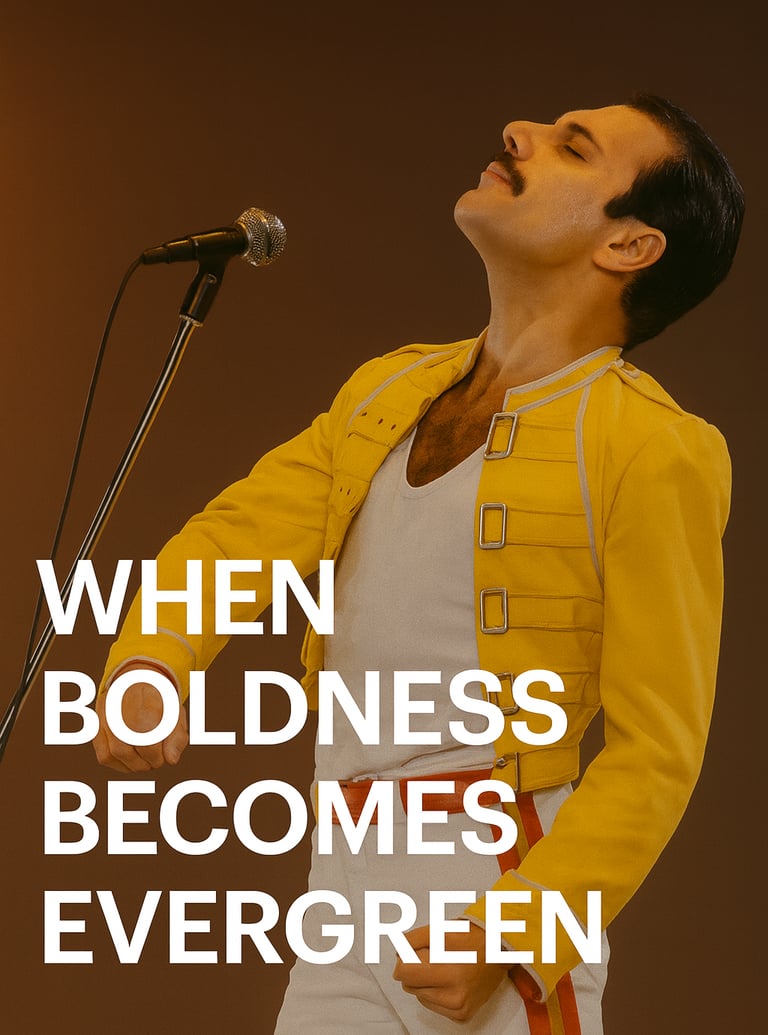How Bohemian Rhapsody Stuck Across Generations—and What Brands Can Learn
Some ideas are too strange to be safe—and too powerful to die.
In October 1975, Queen released what would become their signature song: Bohemian Rhapsody. Clocking in at nearly six minutes, the song defied the prevailing pop formula—no chorus, no steady genre, just an operatic rock journey weaving through ballad, theatrical dramatics, and hard rock. Freddie Mercury called it a “mock opera,” literally stitching together three different songs he had written in his head long before the band ever pressed record (1).
Critics were divided from the start. The Times’ Philip Norman sneered that “The teeny-boppers must be wondering if they have heard aright” (2). Industry professionals worried it would fail—too long for radio, too wild for mainstream consumption. But the band stood firm. Mercury insisted it belong on A Night at the Opera, and in time, public reaction proved the cynics wrong.
Queen’s gamble paid off: Bohemian Rhapsody became a nine-week No. 1 hit in the UK, and later topped charts in Australia, Canada, New Zealand, Ireland, and the Netherlands (1)(3)(4). In the US, it peaked at No. 9 in 1976—still remarkable, given how radically unconventional it was. Retrospective acclaim followed: Rolling Stone ranked it number 17 in their “500 Greatest Songs of All Time,” readers ranked Mercury’s vocal performance as the greatest in rock history, and in 2004 it was inducted into the Grammy Hall of Fame (1).


Why It Ticked Then—and Ticked Again
Authentic, Unapologetic Vision
Mercury didn't ask if it would fit radio expectations. He believed in its authenticity. That conviction gave it gravitas—and the audience responded.
A Multi-Emotional Experience
Few songs deliver vulnerability, tension, theatricality, and release—all in one ride. This emotional layering made people remember it, revisit it, and connect to it across contexts.
Visual Pioneer
Queen’s promotional video for the song—before MTV—changed how music was consumed. It wasn’t just audio; it became a visual event.
Cultural Re-Entry in the ’90s
A turning point arrived in 1992 via Wayne’s World. In a now-iconic scene, Wayne and Garth headbang in their car to Bohemian Rhapsody, and the song exploded back into public consciousness. It reentered the charts, reaching No. 2 on the US Billboard Hot 100 (1)(4)(5).
Mike Myers, who portrayed Wayne Campbell, has said he nearly walked off the movie set because he insisted on keeping that Queen scene. Producers favored a Guns N’ Roses track, but Myers knew the emotional and narrative power Bohemian Rhapsody held—and it paid off (6).
This revival shows how legacy content—when reintroduced in the right cultural setting—can gain new life. It also hints at social inertia: once momentum builds, a piece can sustain itself across decades.
Why Do Certain Cultural Touchstones Stick Across Generations?
Cultural Reproduction & Canon Formation
French sociologist Pierre Bourdieu used the concept of "cultural reproduction" to describe how cultural practices and values get transmitted across generations. Those cultural artifacts with deep symbolic power are continuously reintroduced and revalidated, reinforcing their place in history (7).
In popular music studies, Bohemian Rhapsody exemplifies canon formation—criteria like transcendence, historical importance, and authenticity are applied. If something is seen as "defining," it becomes sticky beyond its era (8).
The Stickiness of Emotional Resonance
In cultural studies, “stickiness” refers to works that resurface in emotionally charged contexts, accumulating meaning over time (9). Bohemian Rhapsody does exactly that: from radio to MTV to Wayne's World to karaoke, each revival adds layers—nostalgia, rebellion, joy.
Social Rituals & Collective Participation
The song is a staple at concerts, sports arenas, and karaoke nights. When cultural artifacts are embedded in shared rituals, they become generational touchstones.
Why do certain creations—whether songs, products, or campaigns—stick in our collective memory while others fade away? And how can brands harness the same forces to create work that lasts across generations? The story of Bohemian Rhapsody holds the clues.
Wrapping It All Up
The Anatomy of a Timeless Cultural Asset
Bohemian Rhapsody has lasted nearly five decades because it embodies six traits that make ideas stick, grow, and reappear across generations. Here’s why it remains timeless—and how T2M&co. can help your brand apply these same principles.
1. Defied Market Formulas
Freddie Mercury refused to follow the hit-song blueprint. By breaking away from predictable formats, Queen created something so different that it couldn’t be ignored.
How We Can Help:
We work with your brand to break out of “category sameness” and uncover the big, bold ideas that no one else in your space is daring to attempt. By grounding creative risks in audience insight and strategic intent, we help you stand apart—not just for shock value, but for meaningful, memorable impact.
2. Offered Emotional Complexity
Bohemian Rhapsody wasn’t one note—it moved audiences from melancholy to joy to exhilaration in under six minutes. That depth gave it replay value across moods and moments.
How We Can Help:
We design campaigns and experiences that speak to multiple emotional layers, so your audience can connect with your brand in different ways, over time. From high-energy moments to intimate storytelling, we help you build the kind of emotional resonance that creates long-term loyalty.
3. Innovated Visually
In 1975, Queen’s promotional video was revolutionary—turning a song into a visual spectacle that deepened audience connection.
How We Can Help:
We bring your brand to life visually—through immersive event design, cinematic content, and creative storytelling that makes your message unforgettable. Our team ensures your audience doesn’t just see your brand; they experience it.
4. Re-Entered Culture at Key Moments
From Wayne’s World in 1992 to the 2018 biopic, Bohemian Rhapsody proved that smart reintroductions can reignite interest and attract new audiences.
How We Can Help:
We monitor cultural trends and milestones to identify the perfect moment for your brand to step back into the spotlight. Whether it’s an anniversary, a partnership, or a trending cultural moment, we create re-entry strategies that feel fresh, relevant, and impossible to ignore.
5. Embedded Itself in Shared Rituals
The song lives on through shared experiences—stadium singalongs, karaoke nights, sports anthems. Participation has kept it alive.
How We Can Help:
We create brand activations that invite your audience to participate, not just observe. From live community events to interactive digital moments, we build rituals your audience will look forward to year after year—transforming customers into active members of your brand story.
6. Was Validated by Institutions
Over the years, the song has been honored by the Grammy Hall of Fame, the Library of Congress, and countless “best ever” lists—cementing its cultural credibility.
How We Can Help:
We position your brand for recognition and authority within your industry. From award submissions to strategic collaborations with respected partners, we help your brand gain the credibility that reinforces long-term relevance.
Final Thought:
Your brand can be more than a fleeting campaign—it can be a cultural landmark. At T2M&co., we partner with you to create bold, emotionally resonant, visually striking, strategically reintroduced, community-powered, and industry-recognized brand experiences that stand the test of time.
Ready to start building your brand’s “Bohemian Rhapsody”? Let’s make it timeless.
References
Wikipedia. "Bohemian Rhapsody." https://en.wikipedia.org/wiki/Bohemian_Rhapsody
Review Gale. "Mixed Reaction to Bohemian Rhapsody." https://review.gale.com/2019/11/20/mixed-reaction-to-bohemian-rhapsody
Vanity Fair. "The Oral History of Wayne’s World Bohemian Rhapsody Scene." https://www.vanityfair.com/hollywood/2014/09/waynes-world-bohemian-rhapsody-mike-myers
Rolling Stone Australia. "The Oral History of the Wayne’s World Bohemian Rhapsody Scene." https://au.rollingstone.com/movies/movie-features/the-oral-history-of-the-waynes-world-bohemian-rhapsody-scene-37178
Wikipedia. "Wayne’s World (film)." https://en.wikipedia.org/wiki/Wayne%27s_World_(film)
Den of Geek. "Why Wayne’s World Needed Bohemian Rhapsody." https://www.denofgeek.com/movies/why-waynes-world-needed-bohemian-rhapsody
Wikipedia. "Cultural Reproduction." https://en.wikipedia.org/wiki/Cultural_reproduction
ResearchGate. "Video cultures: 'Bohemian Rhapsody,' Wayne's World and beyond." https://www.researchgate.net/publication/290566748_Video_cultures_'Bohemian_Rhapsody'_Wayne's_World_and_beyond
Sara Ahmed. "The Cultural Politics of Emotion." https://pratiquesdhospitalite.com/wp-content/uploads/2019/03/245435211-sara-ahmed-the-cultural-politics-of-emotion.pdf
